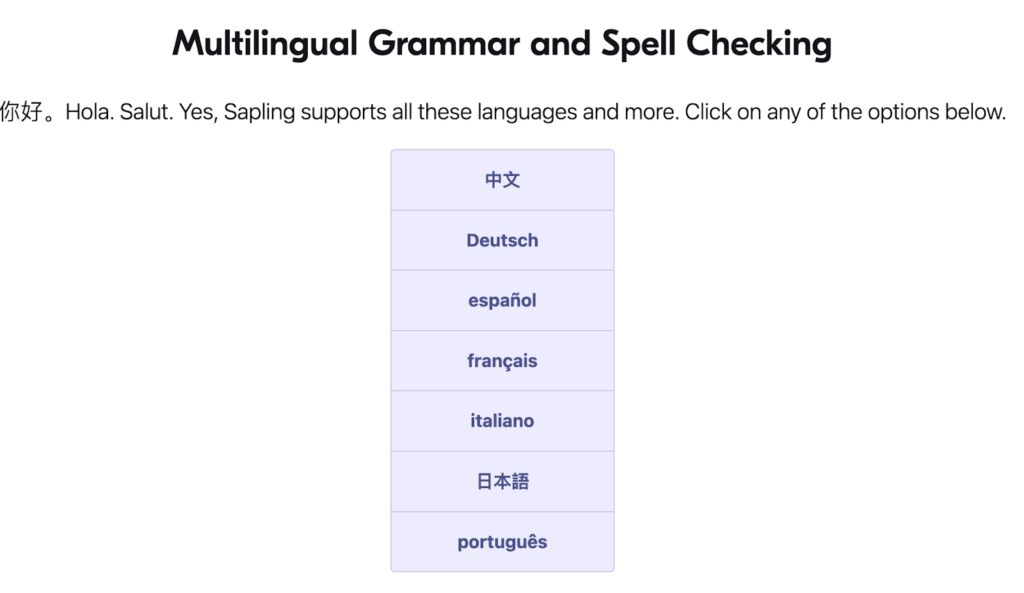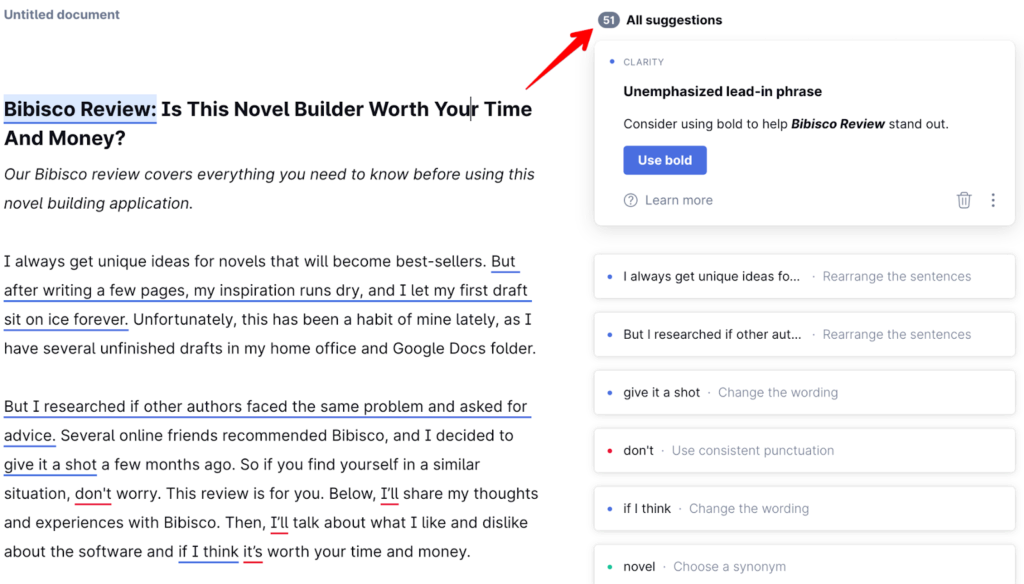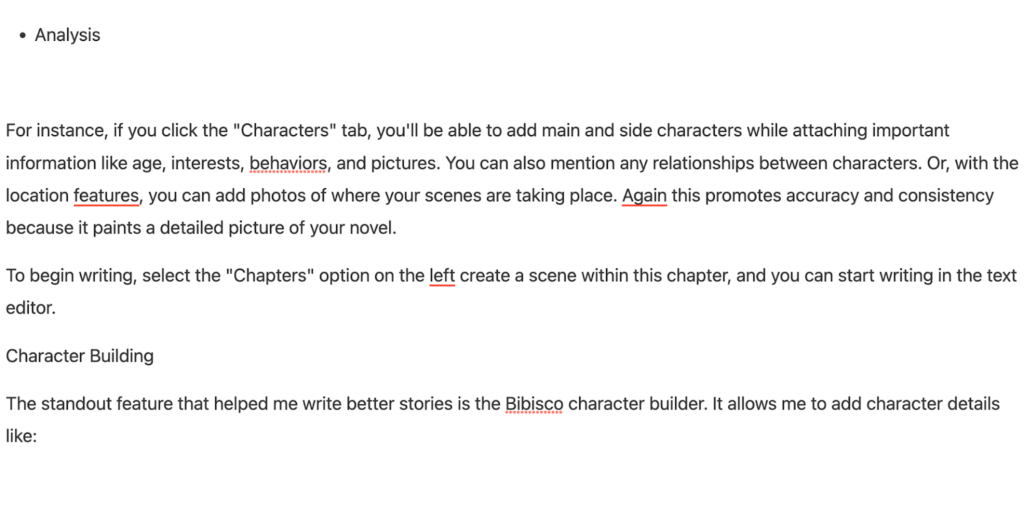Sapling Vs. Grammarly: Which writing software is a better option? Let’s find out!
I’ve been using Grammarly to scan my articles for errors ever since I started my career as a freelance writer. It has helped me spot countless embarrassing mistakes that my audience would have noticed.
However, I never tried Sapling, despite hearing many positive things about it. But when Sapling released a writing assistant, I signed up for a Sapling account and used it to check my work. I also played around with features like the text predictor and keyboard shortcuts to see how they could benefit my work process. Here are the results! Below, I’ll talk about my experience with Sapling and Grammarly, the pros and cons of each, and which is better.
| Product Name | Availability | Pricing | Use For | Features | |
| Sapling | Mac, Windows, and the Sapling web app. | $25 per month or $144 per year. | Customer-facing teams looking to reduce response time. | Chat macros, suggested responses, autocomplete. | Try Now |
| Grammarly | Mac, iOS, Windows, Android, and Grammarly desktop app users. | $29.95 per month, $59.95 every three months, or $139 per year. | Anyone looking for a writing assistant and plagiarism checker in one. | Tone recognition, vocabulary enhancement, plagiarism detection. | Try Now |
We tested dozens of grammar checkers, and Grammarly is the best tool on the market today. It'll help you write and edit your work much faster. Grammarly provides a powerful AI writing assistant and plagiarism checker.
Contents
What Are Sapling And Grammarly?
Sapling is an AI messaging tool built for customer communication. It provides autocomplete suggestions across platforms like Gmail and Slack, reducing your response time to customer messages.
Sapling also introduced a grammar checker recently, which double-checks your writing before you send it to customers. On the other hand, as mentioned in our Grammarly review is a more advanced writing assistant that spots various types of problems including:
- Readability
- Plagiarism
- Grammar
- Spelling
- Sentence structure
Pro tip: If you’re completing an article and want a professional to review it, feel free to hire a real-life editor with Grammarly. Simply head to your dashboard and in the bottom right-hand corner, click “Get Expert Writing Help.”
What Has Sapling and Grammarly Have In Common?
Grammarly has been a staple in my creative process for as long as I can remember. But when I experimented with Sapling, I noticed the following similarities:
- Grammar checker
- Tone checker
- Integration with Google Docs
The main similarity between Sapling and Grammarly relates to writing assistant, grammar and tone checkers. Sapling and Grammarly will scan your work and point out issues within seconds.
These tools also understand that you’ll use various writing styles for different formats. For instance, if you’re writing an email to a friend, you’ll probably use some slang. But if you’re emailing a customer, you’ll keep things professional. Fortunately, Sapling and Grammarly allow you to change tone suggestions, tailoring edits around your writing voice.
Sapling and Grammarly’s integration with Google Docs was the last similarity that stood out to me. Because I use Google Docs to write articles, I like that I can check my work without copying the entire document.
Sapling Vs. Grammarly: The Differences
The main difference between Sapling and Grammarly is that Sapling is tailored around customer-facing teams e.g., customer service and customer success teams. The developers introduced functions such as:
- Chat macros
- Suggested responses
- Autocomplete
- Customer analytics dashboard
- API access
These features help your organization save time. Instead of typing a 200-word email, Sapling will predict what to write next based on your typing history. Initially, it’s still trying to understand your writing habits, but the longer you use it, the more it learns and the better it gets.
Grammarly is targeted toward freelance writers, authors, and students. It might not have the extensive features that Sapling has, but its accurate writing assistant makes up for it. You can scan for grammar, spelling, plagiarism, readability, and style issues.
What’s Better About Sapling?
Here are some benefits of using Sapling that Grammarly doesn’t offer:
- Sapling has more features
- Sapling works in multiple languages
Sapling Has More Features
Sapling is so much more than a writing assistant. It has functions like:
- Customer analytics
- Live chat responses
- Snippets
- Autocomplete
- Custom reporting
So, for example, if you want insight into what messages customers respond well to, go to your dashboard analytics. Here you’ll find conversational insights that you can use to train employees.
Sapling Works In Multiple Languages
I also like that Sapling offers grammar checking in several languages, including:
- Spanish
- French
- German
- Portuguese
- Chinese
- Italian
- Japanese

So it doesn’t matter what language you’re writing in, Sapling will scan your work for errors. Unfortunately, Grammarly only works in English, so it’s impractical if you create content in other languages.
What’s Better About Grammarly?
However, Grammarly provides a few unique benefits that I never experienced when using Sapling:
- Grammarly is easier to use
- Grammarly is more accurate
Grammarly Is Easier To Use
When I first signed up for Sapling, the AI greeted me with an interactive tutorial and walked me through all the shortcuts and features. However, there wasn’t a tutorial discussing how to communicate with clients and integrate Sapling into Gmail or Slack.
This is why I have to give Grammarly the advantage. Grammarly’s tutorial makes everything easy to understand and has zero learning curve. I went from knowing nothing about Grammarly to fully integrating it into my creative process within 20 minutes.
Grammarly Is More Accurate
Few writing assistants can compete with Grammarly when it comes to accuracy. I always accept around 70 to 80 percent of Grammarly’s suggestions, and Sapling doesn’t come close.
To test my theory, I pasted this Bibisco review into Grammarly and the AI found 51 writing issues. See how Grammarly underlines my work in blue to show that I can improve readability? Sapling has none of that.

This is the problem with Sapling. It spots basic grammar and spelling errors. Sapling won’t notice if your messages are hard to read or you overuse a particular word.

So if you don’t care about fancy customer communication features and only need the most accurate writing assistant available, Grammarly is your best bet.
Who Should Get Sapling?
While there are similarities, Sapling and Grammarly target different audiences. Sapling can improve the lives of:
- Business owners
- Customer support teams
- Freelancers
Business Owners
Sapling provides a handy enterprise plan that grows with you, making it perfect for business owners leading sales or customer support teams.
It offers unlimited text snippets, chat suggestions, customer analytics, and keyboard shortcuts. I’m a big fan of these shortcuts because I can add custom phrases to my knowledge base and assign a shortcut to it.
Sapling also has built-in shortcuts. For instance, if you want to enter your email address, simply type “ZEM.” Or, if you want to access all suggestions, select Ctrl+O on Mac or Alt+O on Windows.
Customer Support Teams
Ziang Xie founded Sapling to help customer support teams. Although it branched out into grammar checking, customer support is still where Sapling’s power lies. For example, if a customer is trying to reset their password and they ask you for help, Sapling’s AI will recognize this and present you with possible responses like:
- Would you like me to reset your password?
- I will send you an email to reset your password shortly.
- Are you seeing any error messages when logging in?
Freelancers
But this intuitive AI doesn’t just benefit large teams dealing with high volumes of customer requests. If you’re a freelancer juggling multiple clients, use Sapling to save time.
Let’s say a client is requesting a few revisions. Instead of typing a response, use the text snippets at the bottom. Or, if an email requires a personalized response, start typing, and after a few words, the Sapling AI begins to predict what you will say.
Who Should Get Grammarly?
After using Grammarly for several years, I’ve noticed it can empower:
- Bloggers
- Students
- Authors
Bloggers
Grammarly is a must-have for bloggers because it significantly reduces editing time. When you paste your work into the web app, you can customize suggestions based on your writing voice.
So if you spend several hours proofreading and there are still writing errors in your blog posts, try Grammarly’s free version. Signing up takes a few minutes, and you’ll find basic writing mistakes. As you get used to Grammarly, upgrade to the paid plan.
Students
Since 89% of students say Grammarly helped improve their grades, I recommend using Grammarly when writing essays and completing school projects.
But what stands out is the plagiarism checker. Plagiarism has severe consequences, as many educational institutions will suspend or even expel students who plagiarize work. With Grammarly, you can paste your work into the plagiarism checker and spot duplicate content.
Authors
Editing your novel’s first draft is one of the hardest parts of being an author. Not only must you spot spelling and grammar issues, but you’ll also have to fix potential plot holes. By pasting your first draft into Grammarly, you reduce the number of small errors, allowing you and your editors to focus on correcting more serious issues.
My Testing Criteria
When testing Sapling and Grammarly to see which is a better option for writers, I considered these criteria:
- Ease of use
- Accuracy
- Affordability
- Additional features
The first thing I looked at was the ease of use. The interactive tutorials make it easy to utilize both platforms to their full potential.
Next, I considered the accuracy of Sapling and Grammarly. Sapling falls short in this department. It won’t scan your work for readability and style problems nor suggest ways to restructure your sentences. I prefer Grammarly. Although not perfect, it spots issues that most tools don’t.
The last two factors were affordability and additional features, which are also strengths of Sapling and Grammarly. It isn’t expensive, especially on the annual plan, and you can access various unique features like a plagiarism checker and automated responses.
Why You Can Trust Me
I’ve been creating various forms of content, such as blog posts and email copy, for several years. My goal was to help other writers master their art by writing informative articles and product reviews. To achieve this, I’ve bought and used countless writing tools to provide unique insight to writers who don’t know if a particular software product is for them.
Before writing this review, I used Grammarly for around five years. I’ve also extensively reviewed other grammar checkers for Become a Writer Today.
Sapling Vs. Grammarly: The Final Word
Sapling and Grammarly are two pieces of software that’ll benefit different types of people. If you’re part of the customer support industry and looking to reduce your response time, opt for Sapling’s AI messaging tool. But if you’re a writer and you need the most accurate writing assistant available, try Grammarly instead.
